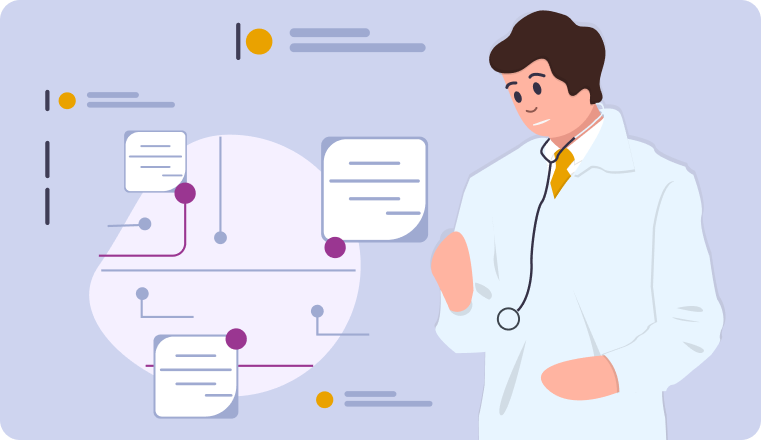Innovation has driven a 33% decrease in cancer mortality in the last three decades - and AI could be the next (and most revolutionary) phase of that evolution. But the sheer volume of speculation about this new technology has left many cancer center leaders uneasy:
How should you approach concerns around AI safety and ethics? What can they do to protect care quality and job security?
This article answers these questions and helps demystify AI for those working at the forefront of cancer care. But before we can explore specific concerns around AI, we need to understand exactly what this technology is at its core.
How AI-Driven Cancer Solutions Work
The potential use cases for AI within oncology are vast – from diagnostics and precision oncology to clinical trial matching and risk management. Yet these varied use cases share a pair of core elements:
- Data Requirements: Most require a large volume of data to perform their function, whether it’s “training data” for a diagnostic system to learn how to detect complex patterns in radiology images or simply accessing the cancer registry to assess trial feasibility.
- Automation: Most augment or supplant tasks traditionally undertaken by highly skilled humans, usually accelerating the process to save time or effort.
These factors help explain why AI raises concerns for many, especially given how rapidly it has gone from a fringe interest to a driving force within the scientific mainstream.
What Are the Most Common Concerns?
Solutions that demand high volumes of data and automation present several challenges for cancer centers:
- Data Privacy: Real protected health information (PHI) must be used to make most AI systems effective, which means the solution will need to be integrated into existing IT systems. However, healthcare security and privacy measures are already inadequate in many places, and introducing new AI systems too hastily may create a heightened risk of data breaches or cyber-attacks.
- Accuracy: Overreliance on AI for diagnostics and analysis may lead to avoidable oversights. Human oncologists may cede control or outsource work to AI solutions – and fail to identify tumors during early scans.
- Patient Care: Many claim that cancer patients will interface with AI-driven systems in the future to help explain their treatment and even develop their care plans. However, this raises concerns about the human element of care and presents a plausible future in which care is highly impersonal.
- Explainability: Some AI solutions are known as “black boxes,” which means they cannot explain their decisions or actions. Allowing such systems to direct or deliver care to vulnerable cancer patients presents a clear ethical problem.
- Job Security: Automating repetitive tasks is great if used to free oncology professionals and let them focus on other important work. But many fear AI will instead be used to reduce staffing requirements and cut costs within budget-stretched cancer centers.
All of this puts leaders in a tough spot: they have seen the fast-growing body of evidence that shows AI can dramatically improve diagnostics, cancer registry efficiency, and various other areas of the cancer center – but they are unsure exactly how to introduce it safely.
How to Implement AI Safely
To illustrate the principles of AI safety that cancer center leaders should follow, let’s take a single use case. Cancer registries are the perfect example because AI presents all the concerns raised above – and the right solution and implementation plan can resolve them all.
First, let’s establish how AI can be used within a registry. Natural language processing (NLP) will ingest and sort a vast quantity of structured and unstructured patient information, which forms a powerful data foundation. Then, various analyses can be performed to produce outputs such as casefinding, pre-abstracting, trial matching, and more.
This produces a wide range of benefits, such as:
- Reducing manual effort for overworked and understaffed ODSs
- Accelerating casefinding and abstracting to eliminate case backlogs
- Improving the clinical trial recruitment process and increasing trial accrual
Now let’s consider how these could be achieved safely. There is an important difference between two different forms of AI:
1. Generative AI: A subset of AI that produces novel outputs based upon large datasets, including tools like ChatGPT. These tools rightly raise anxieties amongst oncology professionals about the misappropriation of information for two reasons:
- They must be “trained” on data, which can lead to biased outputs that compromise patient care.
- They are “black boxes” which cannot explain why a particular output or answer has been generated.
Inspirata’s E-Path and E-Path Plus are both built exclusively using rules-based AI. They use explicit rules that are added from the user’s documentation, and, therefore, present none of the risks associated with generative AI.
Better still, these solutions assuage several other common fears about the safety or ethics of AI:
- Registrar Jobs Are Safe: Most registries currently need to hire more ODSs, so AI can help them reduce the burden on existing staff and reallocate time to other value-generating tasks. Importantly, AI is not a replacement for human expertise; it is designed to augment the ODS’s skills and support repetitive daily tasks.
- Outputs are Reliable: Data can be easily verified, and AI actually improves data quality and accuracy by eliminating human error.
- Data is Secure: Solutions like Inspirata’s E-Path and E-Path Plus integrate directly with your electronic health records (EHRs) and have built-in security best practices to ensure data usage is safe and compliant at all times.
Want to explore how AI could elevate your registry?


